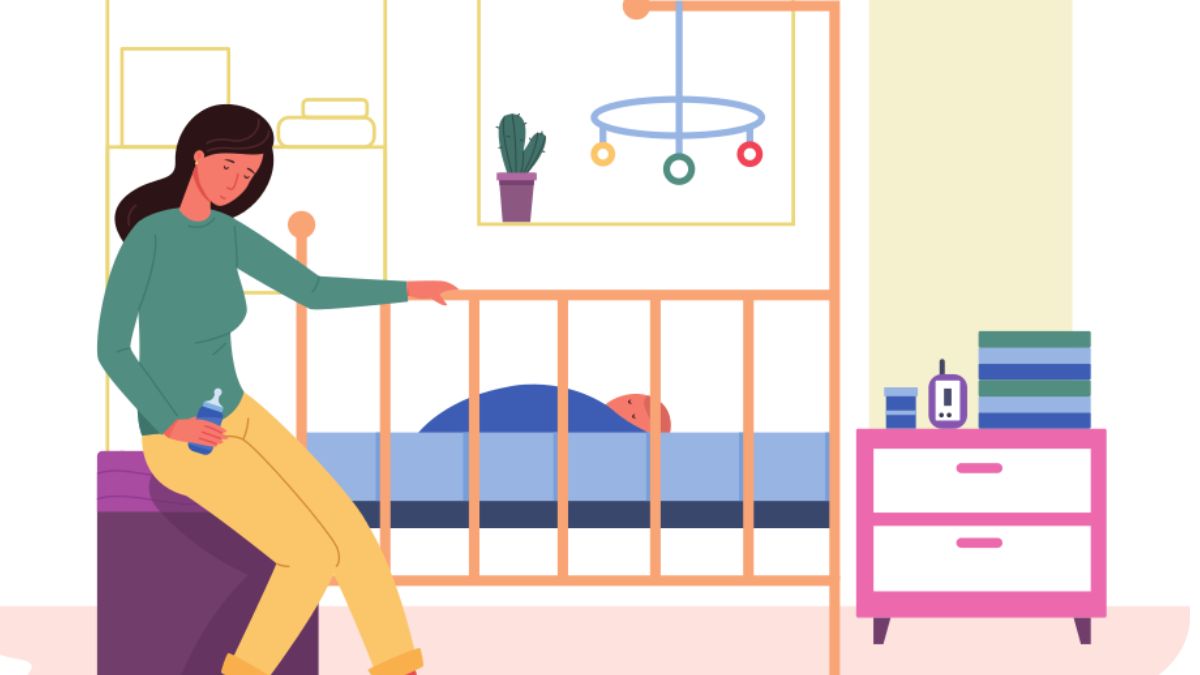Sleep training a 5-month-old can be a daunting task for many parents, but with the right guidance and patience, it is possible to help your baby learn to sleep through the night.
However, before beginning any sleep training program, it is important to understand both the benefits of sleeping training and its potential drawbacks so you can make an informed decision about what will work best for your family.
This article will provide information on how to successfully sleep-train your 5-month-old baby!
What is Sleep Training?
Sleep training is a process wherein parents help their children learn healthier sleep habits. It involves gradually teaching your child to fall asleep and stay asleep for longer periods, as well as developing consistent bedtime routines.
Sleep training helps babies and toddlers transition from sleeping randomly throughout the day and night to more regular and predictable sleep schedules.
Benefits of Sleep Training for a 5-Month-Old
Sleep training can help a 5-month-old baby learn important, healthy sleep habits and improve the overall quality of sleep. The main benefits of sleep training at this age include the following:
1. Developing routines
Consistent sleep routines help babies transition into regular sleeping patterns that contribute to overall well-being.
When a sleep routine is established, babies learn to ease themselves into sleep at the same time each night and wake up on a regular schedule.
2. Encouraging independent sleep
As babies grow, parents can gradually introduce more independent sleeping habits. By five months, most infants have developed enough cognitive skills to be more capable of self-soothing.
With sleep training, babies can learn how to comfort themselves and put themselves back to sleep if they wake up during the night.
3. Improving sleep quality
Poor sleep quality can harm a baby’s overall health and development. Healthy, consistent sleep habits can improve sleep quality and duration, leading to better physical and mental health.
For example, a 5-month-old baby who has been sleep-trained may be able to settle down for naps at regular times throughout the day and fall asleep more quickly at night.
They will also be less likely to experience frequent wakeups and be able to fall back asleep without the help of a parent.
This will lead to better quality sleep for both the baby and their parents and improved physical and emotional health.
Different Sleep Training Methods for a 5-Month-Old
Any parent with a 5-month-old knows that, inevitably, sleepless nights will commence. The good news is that there are several tried and tested methods for helping your little one learn to sleep through the night.
Let’s take a look!
Ferber Method
The Ferber Method, also known as “graduated extinction,” is a sleep training technique developed by Dr. Richard Ferber.
It involves gradually increasing the amount of time between your responses to your baby’s crying and comforting them until they can self-soothe and fall asleep on their own.
This method is beneficial for babies aged between 4-6 months old.
No-Cry Sleep Method
The No-Cry sleep method is a gentle sleep training technique developed by Elizabeth Pantley. It emphasizes modified routines and positive reinforcement to help children learn the skills they need to have good sleep habits.
The goal of No-Cry sleep training is to help your child become an independent sleeper without leaving them feeling abandoned or neglected.
The No-Cry sleep method uses behavior modification techniques to gradually teach your child healthy sleep habits.
An essential part of the method is establishing a consistent bedtime routine and sticking with it every night.
This could include warm baths, storytime, singing quiet songs, or cuddling before bedtime.
This method works best for babies aged between 4-12 months old.
The Pick-Up/Put-Down Method
The Pick Up/Put Down method involves responding to your baby’s cries with gentle, comforting touch and words, then returning the baby to their crib or bassinet after calming them down.
This type of sleep training relies on providing comfort while teaching babies to soothe themselves to sleep.
When implementing the Pick up/Put Down method, it is important for parents to respond quickly and consistently when their baby cries, especially during the initial stages.
After picking up your baby, soothe them by talking in a gentle and reassuring manner or providing a pacifier if they are old enough.
You can also rock them gently or sing a lullaby if they are calm enough to appreciate it. Once your baby is settled, place them in their crib, ensure they’re swaddled, and leave the room.
The Cry-It-Out (CIO) Method
If your child wakes up often at night or has difficulty falling asleep, you might try using a gradual CIO approach.
You can do this by providing a few minutes of comfort and reassurance, then leaving the room while they attempt to self-soothe.
As your child learns to fall asleep independently, you can gradually increase the time between these “check-ins” until they can sleep through the night.
Bedtime Fading Method
The Bedtime Fading method of sleep training works by gradually shifting baby’s bedtime earlier and earlier while teaching them self-soothing strategies they can use at night when they wake up or get restless.
For example, if your baby’s current bedtime is 10 PM, you can start Bedtime Fading by shifting it to 9:30 PM.
A few days later, shift it to 9 PM and then to 8:30 PM. By gradually making the bedtime earlier and earlier, your child will eventually become accustomed to falling asleep at an earlier hour.
How to Sleep Train a 5-Month-Old
As infants become increasingly active and aware of their environment, parents may face difficulty getting them to sleep during the night.
Sleep training your 5-month-old can effectively address this issue, allowing both you and your baby to get the rest you deserve.
Follow the steps below to learn the process of sleep-training!
1. Establish a bedtime routine
You should create a consistent and predictable bedtime routine for your 5-month-old that signals it’s time for sleep.
This can include giving them a warm bath, reading to them, singing lullabies, or having skin-to-skin contact.
Keeping this same pattern every night will help your baby learn it’s time for sleep.
2. Put your baby to bed awake
Ideally, you want your 5-month-old to fall asleep independently without relying on external comfort from a parent or pacifier.
To do this, put them into their crib while awake but relaxed. You can do this by having a “transitional object” available, like a stuffed animal or special blanket, to clutch onto when they feel alone in the crib.
3. Allow your baby to fall asleep on their own
Once you have placed your 5-month-old in the crib, don’t rush in to rescue them when they cry.
Wait a few minutes and give your baby a chance to fall asleep independently.
If the crying persists, you can go into the room and comfort your baby by patting their back or rubbing their head, but don’t pick them up out of the crib.
4. Reward success
If your 5-month-old can fall asleep independently, you should reward that success. Praise them verbally or give them a small toy they can keep next to the crib.
This will reinforce positive behavior and help your baby learn that falling asleep independently leads to rewards.
5. Be consistent
It’s important to be consistent with your sleep training. Doing the same bedtime routine each night and allowing your baby to fall asleep on their own will help them learn how to self-soothe, resulting in better sleep for you and your little one.
Common Challenges of Sleep Training

Sleep training can be a tricky process for both parents and infants. Many parents have found success in having consistent sleep routines for their children, but it’s essential to recognize that some common challenges come with sleep training.
1. Crying
One of the most common challenges in sleep training is dealing with a baby who won’t stop crying.
While it can be difficult for both you and your baby, remember that this is a part of the process, and try to remain patient and consistent in how you respond to their cries.
If you need a break, step away for a few minutes and take deep breaths until you feel calmer.
2. Refusing to sleep
Another common challenge is when your baby refuses to sleep at bedtime or wakes up frequently.
It’s essential to remain consistent in your response and try not to give in to their demands.
If they resist sleep, you can try using a dim night light in their room or playing soft music to help them relax and settle down.
3. Overstimulation
It’s important to ensure your baby’s bedroom is not too stimulating and that no distractions could disrupt their sleep.
If your baby is easily distracted by noise or bright lights, try positioning their crib away from the window and using blackout curtains to ensure the room stays dark.
4. Lack of routine
Establishing a consistent bedtime routine can be one of the most effective tools for successful sleep training.
Try to create a calming environment and perform the same activities each night before bed, such as a bath or cuddle time.
This will help your baby recognize when it’s time for sleep and make them feel more secure in their environment.
Tips and Tricks for a Successful Night’s Rest
One of the new parents’ greatest challenges is getting a successful night’s rest with their baby. Here are some helpful tips and tricks that can help make nighttime smoother!
1. Keep your baby in their crib
To help your baby learn how to self-soothe, it is important to keep them in their crib while they are sleeping.
This will help them understand that a crib is a safe place to sleep and reduce the temptation for you to intervene if they wake up during the night.
2. Create a healthy sleep environment
Your baby’s bedroom should be a quiet and calming environment that helps to promote sleep.
Make sure the room is dark, no loud noises or bright lights are coming from outside, the temperature is comfortable, and there are minimal distractions such as toys or electronics.
3. Monitor your baby’s sleep cycles
To help you determine when your baby is ready for sleep, track their sleep cycles throughout the day.
This will give you a better understanding of how much rest they need and help you to establish a consistent bedtime routine.
4. Use positive reinforcement
Sleep training is all about positive reinforcement and setting expectations for your baby.
If your baby wakes up during the night and cries, it is important to remain calm and give them gentle encouragement if they can settle themselves back down.
This will help them understand that a crib is a safe place for sleeping, even when no one else is around.
5. Allow for flexibility
While consistency is important in sleep training, it is also essential to be flexible and adjust your routine as needed.
If your baby is having a particularly rough night, try to adapt their bedtime routine or give them an extra snuggle before they sleep.
6. Take care of yourself
Taking care of a newborn can be exhausting, and it’s essential to ensure you get enough rest and care for your needs.
Talk to family and friends for support, schedule time for yourself, and don’t be afraid to ask for help from others if you need it.
When to Seek Professional Help for Sleep Training a 5-Month-Old
If your five-month-old is having difficulties with sleep training, it might be time to seek professional help.
Consulting with a child psychologist or sleep specialist can give you more insight into the root cause of their difficulty and provide valuable advice on how to approach the situation best.
These professionals can also help create an individualized plan tailored to your five-year-old’s needs and provide resources to help you through the sleep training process.
It is also important to be aware of any potential underlying medical issues contributing to your child’s difficulty with sleep training.
If you suspect that there may be a physical or mental health condition that is affecting your 5-month-old’s sleep, it’s best to seek the advice of a doctor or specialist.
Frequently Asked Questions (FAQs)
Do pediatricians recommend sleep training?
For optimal sleep results, many pediatricians recommend beginning sleep training before your baby reaches the separation anxiety stage at eight months.
Introducing these techniques can help them develop their independent sleep skills as early as four to six months old.
Is sleep training psychologically damaging?
It is understandable why some could regard these strategies as horrifically damaging on an emotional level, while proponents of sleep training disagree and describe it as teaching a child the skills they need to develop normally.
Ultimately, whether or not parents decide to pursue sleep training methods should be based on careful consideration of the potential risks and benefits.
What is the 15-minute rule for sleep training?
This technique encourages parents to start with short sleep intervals and gradually build up the amount of time their child sleeps.
It’s done by setting a timer for 15 minutes, starting when your child is awake in the evening and placing them in the crib or bed when they become drowsy or fall asleep.
Each day, increase the timeframe by 5 minutes until your child can sleep for 30-45 minutes.
How many days does it take for sleep training to work?
Sleep training often takes two to four weeks, but results vary depending on your child’s age, temperament, and responsiveness to the chosen method.
Throughout this period, parents must be true to their plan so that their children can learn how to self-soothe consistently.
Can babies learn to fall asleep on their own without sleep training?
Babies often learn how to self-soothe and fall asleep on their own with just a bit of patience and guidance.







